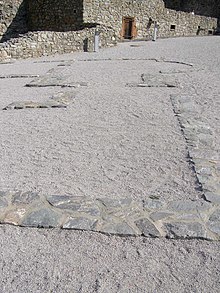Devín Castle
| Devín Castle | ||
|---|---|---|
|
View of the ruins of the castle |
||
| Alternative name (s): | Theben Castle / Theben Castle | |
| Creation time : | around 700 to 800 | |
| Castle type : | Hilltop castle | |
| Conservation status: | ruin | |
| Place: | Bratislava | |
| Geographical location | 48 ° 10 '25 " N , 16 ° 58' 42" E | |
|
|
||

The Devín Castle (German Burg Theben / Thebener Burg , Slovak Devínsky hrad or Hrad Devín ) is a ruin in the district of the same name in Bratislava in Slovakia .
It has an important identity-forming function for the Slovaks, because they see their roots in the remains of the Old Slavic ruins as one of the Slavic nations that emerged from the Moravian Empire.
location
The castle rises as the ruin of an imposing fortress on the rock massif at the confluence of the March and Danube rivers high above the Marchfeld in front , at the foot of the 513 meter high Thebener Kogel , with which the Little Carpathians opposite the Hundsheimer Berg at the Danube Gorge (the Thebener Gates , formerly Porta Hungarica).
origin of the name
The origin of the Slavic name of the castle and the place of the same name ( Devín ), which is passed down from the Middle Ages ( 864 ) as "Dowina, id est puella" (German Dowina, meaning maid), has not been clarified with certainty. It could come from the Slovak word "deva" / "dievka", which means something like "Magd" / "Mädl" (compare German Magdeburg ). According to some Slovak authors, the name could also come from the name of the Slavic goddess Deva . Devín could have been the center of the cult around this goddess. It is also possible to explain that it is a formation of the verb dívať sa = to look, to look out.
history
The castle rock played an important strategic role even before Christ due to its exposed location.
In the first centuries after Christ, this was one of the border stations of the Roman Empire , where Roman legions took over the protection of nearby cities like Carnuntum from the peoples from the north and east.
The castle (Slovak hrad Devín ) was mentioned for the first time in the Fulda annals as Dowina 864. At that time it consisted of a princely castle with a church and tomb as well as protective walls on the Devínska Kobyla mountain behind .
In older research, the assumption was made several times that Devín was identical to the castrum Wogastisburg or that it formed the center of the Samo Empire. However, this is rejected by the archaeologists working there today (Veronika Plachá and Jana Hlavicová), because despite the long and extensive excavations on the castle hill, there are no finds from the 7th century and are only available again from the 8th century.
After Slovakia became part of Hungary after the end of the Moravian Empire (Devín had belonged to Pressburg County since around 1000), the castle belonged to various Hungarian noble families from the 15th century until the fortress was blown up by Napoleonic troops in 1809 . Napoleon and Leopold Pálffy then negotiated , both of whom agreed that Vienna would be supplied with Pálffy products.
The national myth and the tradition of national pilgrimages was established on April 24, 1836 by Ľudovít Štúr and his companions who climbed the castle rock that day.
On July 18, 1896, the 33-meter-high Árpád column , standing on a granite plinth on the castle rock, was inaugurated, which was to symbolize the millennial kingdom of St. Stephen's (Hungary). From then on, the castle massif was called Árpádfelsen, a name that persisted among the German and Hungarian population until 1945. However, the column was blown up by Czechoslovak legionaries on December 31, 1918 , and the remains of the monument were later brought to Hungary .
In 1961 the castle ruins were declared a national monument and have since been expanded into an open-air museum.
According to archaeological finds, there was a church school at Devín Castle. Possibly it is the so-called Moravian Academy, founded by Cyril of Saloniki in 863 , in which future Slavic priests and administrative staff were trained and which became the center of Slavic literature.
literature
- Tatiana Štefanovičová, Devín and Pressburg (Bratislava) - two important castles of the early Middle Ages on the middle Danube. In: Alfried Wieczorek / Hans-Martin Hinz (eds.), Europäische Mitte um 1000 (Stuttgart 2000) 327-329, ISBN 3-8062-1545-6 , ISBN 3-8062-1544-8 .
- Veronika Plachá / Jana Hlavičová, Devín. Slávny svedok našej minulosti. Ilustrované dejiny (Bratislava 2003) ISBN 80-8046-231-3 (popular scientific and richly illustrated overview from prehistory to the present day with detailed summaries in English, German and Hungarian as well as bibliography).
Individual evidence
- ^ The History of the Rise, Progress, and Overthrow of Napoleon Bonaparte: With a Summary Account of the Circumstances which Paved the Way to the French Revolution Together with a History of the Wars, page 650, Theophilus Camden, J. Stratford, 1814.
Web links
- Entry about Devín in the scientific database " EBIDAT " of the European Castle Institute
- Official website for the museum on the castle ruins







